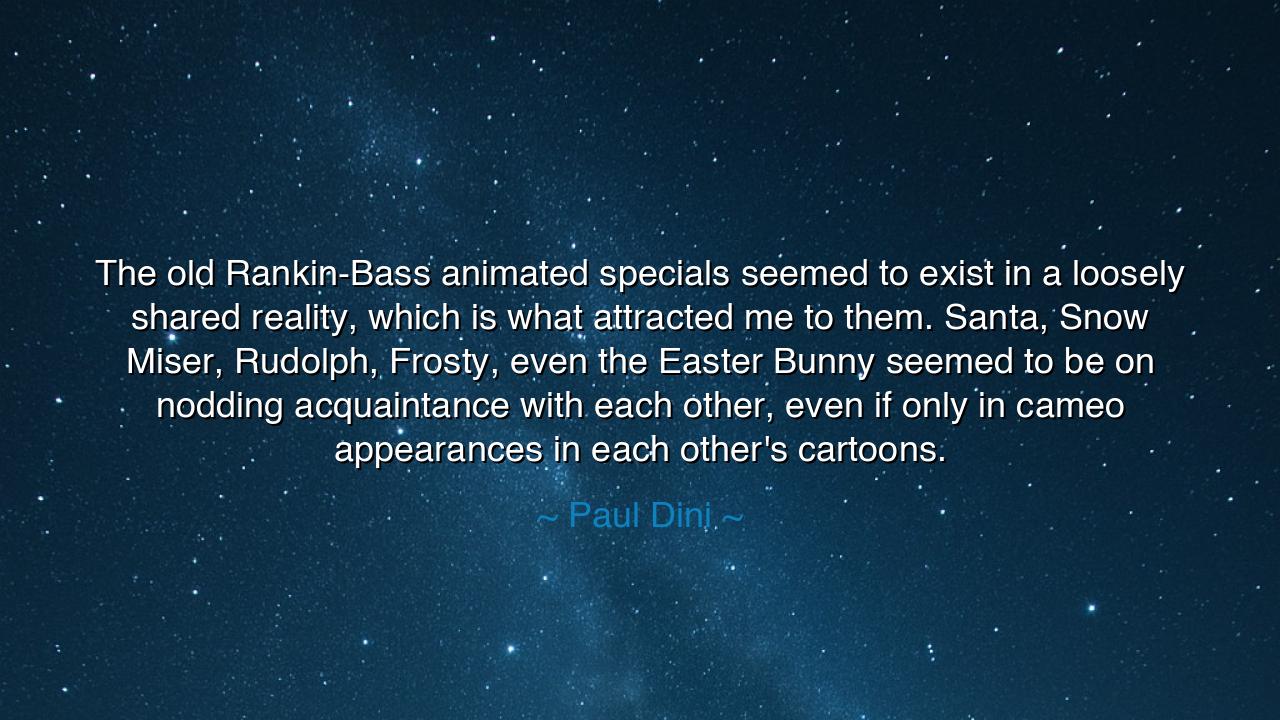
The old Rankin-Bass animated specials seemed to exist in a
The old Rankin-Bass animated specials seemed to exist in a loosely shared reality, which is what attracted me to them. Santa, Snow Miser, Rudolph, Frosty, even the Easter Bunny seemed to be on nodding acquaintance with each other, even if only in cameo appearances in each other's cartoons.






In the wistful and imaginative words of Paul Dini, we hear the voice of a storyteller reflecting on the wonder of childhood and the power of shared imagination: “The old Rankin-Bass animated specials seemed to exist in a loosely shared reality, which is what attracted me to them. Santa, Snow Miser, Rudolph, Frosty, even the Easter Bunny seemed to be on nodding acquaintance with each other, even if only in cameo appearances in each other's cartoons.” Though his words may seem light and nostalgic, they touch upon something timeless — the yearning of the human heart to live in a world of connection, where every story, every soul, and every creature are part of one great harmony.
The origin of this quote lies in Dini’s reflections as a writer and creator, one whose pen has given life to heroes and dreamers alike. Best known for shaping stories of Batman, Dini also cherished the tales that shaped him — those holiday fables crafted by Rankin and Bass, whose stop-motion magic filled television screens in the 1960s and 70s. In those worlds, Santa Claus, Rudolph the Red-Nosed Reindeer, Frosty the Snowman, and others coexisted not as separate legends, but as neighbors in a universe of warmth and wonder. This “shared reality” was not built on logic, but on love — a gentle recognition that joy is multiplied when stories intertwine.
Dini’s affection for this interwoven world speaks to something older than animation itself. The ancients, too, believed in the unity of myths — that the gods, heroes, and spirits were all part of one living tapestry. The Greeks told of Zeus and Hermes walking the earth in disguise; the Norse sang of Odin and Thor battling giants; and the Egyptians saw Ra’s light reflected in every dawn. Though their names differed, their stories were connected, forming one cosmic narrative of meaning and morality. So too, Dini’s childhood world — where Santa might wave to Frosty, and Rudolph might nod to the Easter Bunny — was a modern echo of this ancient pattern. It is the dream that our stories, like our lives, are not isolated fragments but threads in a greater whole.
There is a sweetness in this vision, but also a profound truth. For Dini’s delight in a “shared reality” is more than nostalgia — it is an insight into the human spirit’s deepest need: connection. In a world increasingly divided by difference, the heart longs for the unity once felt in childhood — when all things, even the impossible, could coexist. To a child, it is not strange that Santa and the Easter Bunny might know each other; what is strange is the grown-up insistence that they cannot. The imagination of youth is a temple where all mythologies meet, and Dini’s words invite us back into that sacred space — not to escape reality, but to remember the wholeness we have forgotten.
History offers us kindred spirits who, like Dini, sought to weave the threads of story into one fabric. J.R.R. Tolkien, in his crafting of Middle-earth, built not isolated tales but a mythology of interlocking legends — elves and men, wizards and kings, all part of a shared destiny. C.S. Lewis, too, in his Chronicles of Narnia, created a world where magic, faith, and courage met across seven books, each echoing the others. And before them, the poets of the Mahabharata and the Iliad had already understood that truth wears many faces, but springs from the same divine source. Dini’s childhood realization — that the characters of Rankin-Bass lived in nodding friendship — is an inheritance of that ancient wisdom.
Yet Dini’s reflection carries also a subtle critique — that in our time, storytelling has become fragmented, our heroes siloed, our myths commercialized. Where once imagination sought to unite, now it often divides into competing franchises and disconnected worlds. But the soul, as Dini reminds us, yearns for coherence — for a universe where all stories whisper to each other, where kindness, courage, and joy cross the boundaries between tales. The Rankin-Bass specials, with their handmade charm and gentle humor, reminded us of that possibility. They were not just cartoons — they were a vision of harmony, a reminder that in the vast kingdom of imagination, there are no strangers.
Let this, then, be the lesson for those who listen: cherish the shared realities in your own life. Seek the threads that connect your story to others — in friendship, in art, in love. Remember that the world itself is one great narrative, and that your part in it, however small, touches every other. Be as Santa, generous in spirit; as Rudolph, brave in difference; as Frosty, joyful in heart; and as the Easter Bunny, faithful in renewal. For every myth, every season, every soul, is bound by the same light — the light of creation, which burns not in one story, but in them all.
Thus, in the gentle wisdom of Paul Dini, we find the echo of an ancient teaching: that the universe is one grand tale, told in a thousand voices. When we see that all stories are neighbors, and that every being is in “nodding acquaintance” with every other, we awaken once more to wonder. And in that wonder, the heart rediscovers its home — not in isolation, but in the eternal fellowship of imagination, unity, and love.






AAdministratorAdministrator
Welcome, honored guests. Please leave a comment, we will respond soon